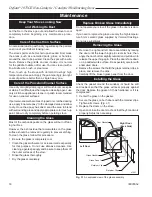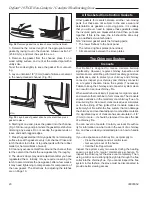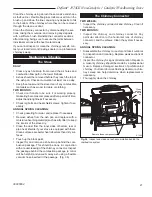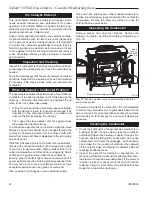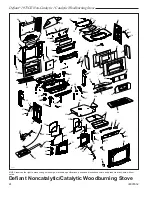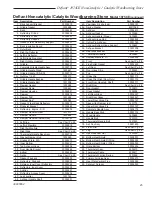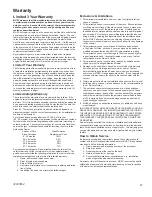
16
Defiant
®
1975CE Non-Catalytic / Catalytic Woodburning Stove
30005554
combustion system in your Defiant work together to pro-
duce optimum conditions for secondary combustion.
When the damper is closed, smoke travels through the cat-
alytic element, which causes ignition of smoke at tempera-
tures of 60°-315°C (500°-600° F), half the temperature
normally required for unaided secondary combustion.
The catalytic element is a ceramic “honeycomb” coated
with the catalytic material. The element is located in the
secondary combustion chamber, molded from a special
high-temperature insulating refractory material. The
chamber provides the correct environment necessary for
secondary combustion of the fuel (smoke).
Closing the damper exposes the smoke to the combustor.
If the combustor is at least 315°C (600°F), it will begin to
burn the smoke.
Closing the stove damper may also reduce the draft, so
to avoid putting out the fire or deactivating the combustor,
close the damper only when a fire is well-established and
the chimney is thoroughly warmed. When starting a fire,
wait until the fire is well established and there is an ember
bed of at least 75 - 100 mm (3-4 inches) before closing
the damper.
Never kindle a fire with colored paper or paper that has
colored ink or a glossy surface, and never burn treated
wood, garbage, solvents, or trash. All of these may poison
the catalyst and prevent it from operating properly. Never
burn cardboard or loose paper except for kindling purposes.
Never burn coal; doing so can produce soot or large flakes
of char or fly ash that can coat the combustor and cause
smoke to spill into the room. Coal smoke also can poison
the catalyst so that it won’t operate properly.
In general, the fire must be sufficiently well-established to
ensure that catalytic activity is initiated. When first starting a
fire, a medium- to high- firing rate must be maintained until
the stove, catalyst, and fuel are all stabilized at the proper
operating temperatures, and the chimney is warmed.
Even though it is possible for the fire to get quite hot within
a few minutes after a fire is started, the combustor may
stop working or the fire may go out if the fire dies down
immediately as a result of the damper being closed. Once
the combustor starts working, heat generated by burning
the smoke will keep it working.
To determine whether the combustor is operating, observe
the amount of smoke leaving the chimney when the damper
is activated and when it is not. This procedure is described
on Page .
Avoid using a full load of very dry wood in the firebox. This
may result in continuous very high temperatures in the
secondary combustion area and damage the combustor.
Wood which has been split, and stored under cover for
more than 18 months may be considered very dry. If you
must burn extra-dry wood, mix it with greener wood for a
longer fire and less stress on the combustor. Also, do not
use a full load of dry slab wood or scrap wood. For long
burns, use a mix of dry and moderately dry wood.
Two ways to add Fuel
The Defiant’s griddle lifts for convenient top-loading of logs,
and is the easiest way to add fuel. (Fig. 7)
However, the front doors open as well for adding an oc-
casional log to a fire. If the stove is equipped with 8” (03
mm) stove pipe, the front doors may be opened (or even
removed) and the optional Defiant spark screen placed
in the opening for open-fire viewing.
The Defiant is not
approved for operation with the front doors open if
equipped with a 152 mm (6”) chimney connector or
chimney.
Defiant
ST521
Intrepid
loading
11/00
ST51
Fig. 27
Top loading is the best way to add fuel during regular
use. Front loading is useful for kindling a fire.
To open the front doors, insert the handle into the door latch
stub and turn it to the left and up. (Fig. 8)
To close them, always close the left door first. Turn the
handle in the right door to the left and up (to the open po-
sition) and close it. Finally, push on the door as you turn
the handle to the right and down. The doors will draw in
slightly, and the handle should offer some resistance as
you turn it to the closed position.
To reduce the risk of breaking the glass, avoid striking the
glass or slamming the doors.
When you are not using the door handle, store it in the
holder behind the right front leg of the stove. Be careful to
not drop the handle, since it is breakable.
ST544
door open
11/00
Clockwise to
Open
Counter-
clockwise
to Close
ST544
Fig. 28
To open the front doors, turn the handle clockwise.

















